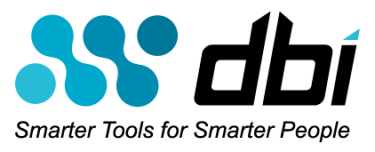By: Greg Robidoux | Updated: 2024-03-25 | Comments (1) | Related: > Tools
The DBI Web Performance Suite for SQL Server and DB2 is a database performance collection, analysis and recommendation tool to help you troubleshoot and tune your database systems. The current version is DBI Web Performance Suite version 7 which was released on April 4, 2022 and supports DB2 and SQL Server. DBI Performance Suite is a mature database performance tool which has been around since 2005 for DB2 and with this extensive knowledge of database performance, DBI Software brings this expertise to SQL Server.
DBI Web Performance Suite for DB2 LUW and SQL Server
- Database Performance Analytics, Tuning, Monitoring, and Trending Solution
- Provides a major breakthrough in performance analysis and change management
- Finds, recommends, and fixes issues related to database health and performance
- Knows what changed, when it changed, and how the changes impacted performance
- Comprehensive history combined with real-time analysis of performance trends
Click Here to Register for a Live Demo
Here are some of the features of DBI Web Performance Suite for DB2 LUW and SQL Server.
Customizable Dashboards
- Overview of all databases monitored by the system
- View best, worst, and average database scores
- Comparative performance charts and metrics
- Individual database dashboards with dynamic date ranges
- Database charts for all metrics that affect performance
Summary statistics
- Statistics for over 3500 metrics with threshold warnings
- Summaries by Users, Apps, Statements, Bufferpools, Tablespaces, etc.
- Support for all types of databases, clustered, simple, pureScale, etc.
- Powerful search, filtering, sorting, moving and fixing columns
- Grouping of similar metrics for easier comparisons and viewing
Responsiveness
- Response Time Analysis and SLA Attainment Analysis
- Monitoring of all transaction times, time distributions, and SLAs
- Report on transactions times inside vs. outside of the database
- Determine the resource bottlenecks for CPU, I/O, Locks, Sorts, etc.
- Shows database availability for different cumulative time periods
Trend Charts
- Chart metrics for a time period to spot any anomalies and trends
- Group similar metrics and compare them side by side
- View database and user changes on the same chart timeline
- Pan and zoom to get high level and detailed views of trends
- Navigate to the activity statistics to pin point specific issues
Advice
- Perform a complete health check for the entire database
- Identify database issues and provide actionable recommendations
- Provide automated index recommendations for problematic statements
- Scan the database and report on invalid objects that need attention
- Report on tables and indexes that need reorg or have stale statistics
SQL Workbench
- SQL tuner with the ability to format and edit the monitored statements
- Display a searchable explain plan in both tree and graphical formats
- Provide index recommendations with percentage of performance gains
- Ability to create new virtual indexes and test them for improvements
- Test virtaul indexes on all statements in a workload to detect degradation
Real Time
- A live dashboard to view real time key metrics that affect performance
- Charts with drill-downs to show details of the state of the database
- Summarize the data by Connections, Applications, Statements, etc.
- View database contentions and locks with the ability to release them
- Finds problems, poor performance, or inefficiencies in the database
Database Alerts
- Advanced Lights-Out, flexible, and customizable alerting Solution
- Monitors databases 24x7 and sends notifications for performance issues
- Provides notifications in a variety of ways (email, traps, SNMP, etc.)
- Over 200 rules out of the box with the ability to create custom ones
- Ability to suppresses duplicate notifications to minimize the noise
Click Here to Register for a Live Demo
About the author
 Greg Robidoux is the President and founder of Edgewood Solutions, a technology services company delivering services and solutions for Microsoft SQL Server. He is also one of the co-founders of MSSQLTips.com. Greg has been working with SQL Server since 1999, has authored numerous database-related articles, and delivered several presentations related to SQL Server. Before SQL Server, he worked on many data platforms such as DB2, Oracle, Sybase, and Informix.
Greg Robidoux is the President and founder of Edgewood Solutions, a technology services company delivering services and solutions for Microsoft SQL Server. He is also one of the co-founders of MSSQLTips.com. Greg has been working with SQL Server since 1999, has authored numerous database-related articles, and delivered several presentations related to SQL Server. Before SQL Server, he worked on many data platforms such as DB2, Oracle, Sybase, and Informix.This author pledges the content of this article is based on professional experience and not AI generated.
View all my tips
Article Last Updated: 2024-03-25
